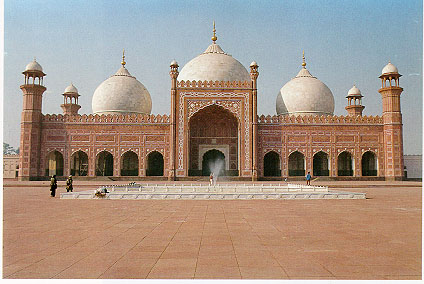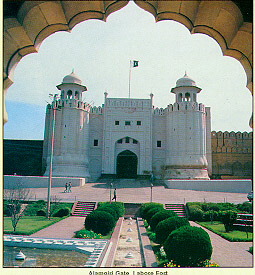The light of Islam penetrated in this part of the world as early as 712 A.D from the west with the Arab General Muhammad bin Qasim and during the 10th century A.D from the north with the Turk Sultan Mahmud of Ghaznah ( better known as Mahmud Ghaznavi).
Islam replaced the early way of life of worshipping idols and introduced new philosophy of faith in one God. With Islam in came a new culture in this land from Arabia and Central Asia. Hence, a new type of architecture, hitherto unknown in this area, was introduced. Tens of thousands of Mosques, Madrasahs, tombs and gardens were created by the Muslim rulers all over the Sub-Continent. The new style of Islamic architecture prevailed and matured in this land for over a thousand years. The direct influence of the Muslim Rulers was not only confined to the architecture; their food added a variety of new dishes in the Sub-Continental cuisine. The national dress of Pakistan, “ Shalwar Qamiz” is also a direct gift of the Muslim Turks.
Since the mother tongue of the Muslim Rulers was Arabic, Turkish and Farsi, it was only natural that the local languages of the Sub-Continent were greatly influenced and new language was introduced. Thus the most important contribution of the Muslim rulers to this land is a new language ‘Urdu’ which became the national language of Pakistan since its independence in 1947.
The legacy of our predecessors at the time of our independence, on August 14, 1947, came to us as a treasure which may be called as Pakistan’s national heritage. So rich and diversified is this heritage that Pakistani nation can be proud of its glorious past, be Islamic, Post Islamic or pre-Islamic period as far back as pre-historic times. No other country of the world can produce the treasure of by gone days as can be found in Pakistan. It is now incumbent upon us to treasure our national heritage and save it from further deterioration and theft.
The establishment of NFCH is much appreciated and a great interest is shown by the general
public hence since its establishment in 1994 hundreds of proposals were received from
different agencies and individuals for the conservation, preservation and publication of
the Pakistan’s national heritage. It is hoped that with the continued patronage of
the government, the Philanthropists and the Business Community to the NFCH we shall be
able to achieve the aforesaid goal.

Badshahi Mosque Lahore

Lahore Fort

Hiran Minar
Cultural Heritage | History | Indus Civilization | Gandhara Civilization | Islamic Period | Sikh Period |
British Period Post Independence | Landscape| Gardens | Museums & Galleries Lahore 100 yrs ago |
| Home | |